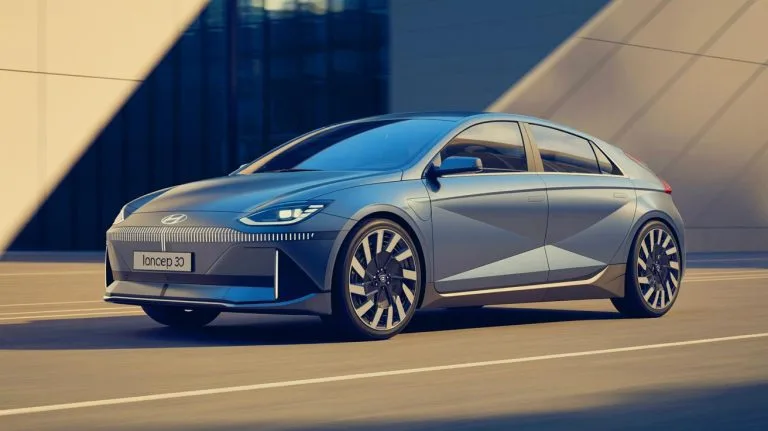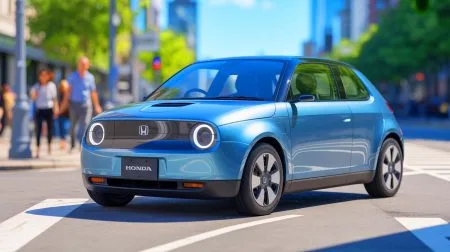| IN A NUTSHELL |
|
Hyundai has taken a bold step forward with the unveiling of its Ioniq Concept 3, a compact electric hatchback that stands out with its innovative design. As part of Hyundai’s Ioniq sub-brand, the Concept 3 follows in the footsteps of the Ioniq 5, 6, and 9, but with a unique twist. This vehicle is not only about aesthetics; it hints at what the future of compact electric vehicles could look like. With plans for production in the near future, the Concept 3 offers a glimpse into Hyundai’s vision for a more playful yet functional automotive design, setting new expectations within the industry.
Revolutionary Design Features
The Ioniq Concept 3 is characterized by its origami-inspired bodywork, featuring sharp, intersecting lines that create a dynamic look. The exterior is finished in an anodized-effect Tungsten Grey, paired with lemon-tinted glass and matching wheels, a combination that evokes a sense of nostalgia akin to a LEGO car set from decades past. This design breaks from conventional automotive styles, offering a fresh perspective on what a compact car can be.
One of the standout features is the wraparound glass, which gives the vehicle a sleek and modern appearance. The upswept rear end and distinctive spoiler enhance its bold stance, although the spoiler may not make it to the final production model. Hyundai has also incorporated exhaust-like outlets that function as speakers for simulated engine sounds, adding to the vehicle’s playful nature.
Innovative Lighting and Technology
Hyundai has advanced its signature pixel lighting concept with the Ioniq 3. The front grille is adorned with animated LED squares capable of displaying messages and characters, while a full-length light bar with pixel elements is featured on the tail lamps. Although the production model will likely see these features simplified, they highlight Hyundai’s commitment to integrating technology in playful ways.
The interior is equally futuristic, with Mr. Pix, a digital avatar, adding personality to the driving experience. The cabin is designed to feel open, with floating seats, handles, and displays. Despite the high-tech environment, Hyundai has wisely included physical climate control buttons, ensuring user-friendly functionality. The steering wheel features a built-in dot matrix display, and the headrests include integrated speakers, showcasing the vehicle’s cutting-edge design.
Performance and Market Positioning
While Hyundai has not yet released official performance specifications or pricing, it’s expected that the Ioniq 3 will share its battery with Kia’s EV3. This means drivers can anticipate a range of up to 375 miles and fast charging capabilities, from 10% to 80% in just 31 minutes, thanks to 81.4-kWh battery cells. These features position the Ioniq 3 as a strong competitor in the compact electric vehicle market.
The vehicle is set to compete against models like Volkswagen’s ID 3 when it arrives in 2026. Initially, the Ioniq 3 will be manufactured in Europe for that market, leaving U.S. consumers to await further announcements regarding its stateside availability. This strategic positioning highlights Hyundai’s aim to capture a significant share of the global compact EV market.
Hyundai’s Vision for the Future
Hyundai’s Ioniq Concept 3 represents more than just a new model; it embodies the brand’s forward-thinking approach to vehicle design and electric mobility. By prioritizing aesthetics, technology, and performance, Hyundai is setting a new standard for what consumers can expect from compact electric vehicles. The playful design and innovative features signal a shift towards more personalized and engaging driving experiences.
This vehicle also marks a departure from the more traditional, boxy SUV designs seen in previous Ioniq models, such as the Ioniq 7 concept. With the Concept 3, Hyundai is emphasizing the importance of diversity in its vehicle lineup, ensuring that there is something for every type of driver.
As the automotive industry continues to evolve, Hyundai’s Ioniq Concept 3 challenges preconceived notions of what a compact electric vehicle can be. With its innovative design and technological advances, it sets a high bar for future developments. As we look forward to the production model, one question remains: How will Hyundai continue to innovate and push the boundaries of electric vehicle design in the years to come?
Did you like it? 4.6/5 (29)






